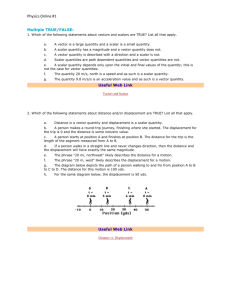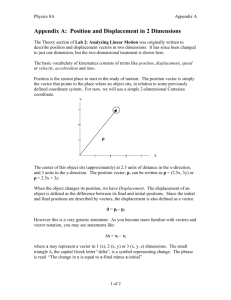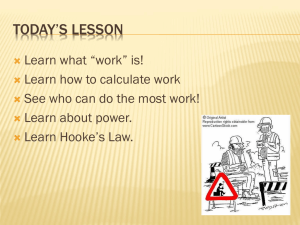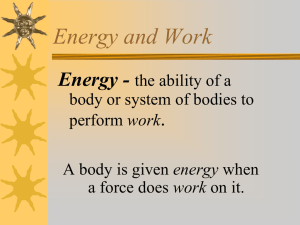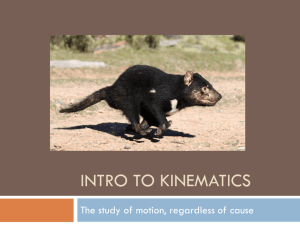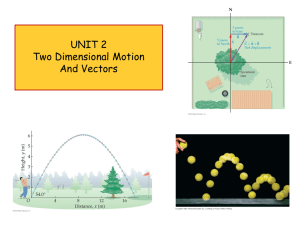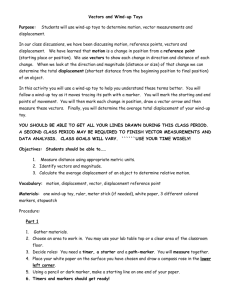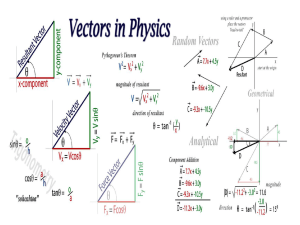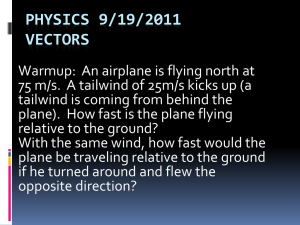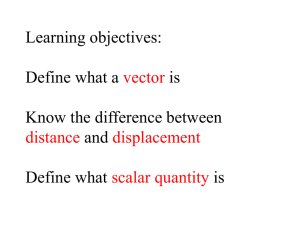File
advertisement
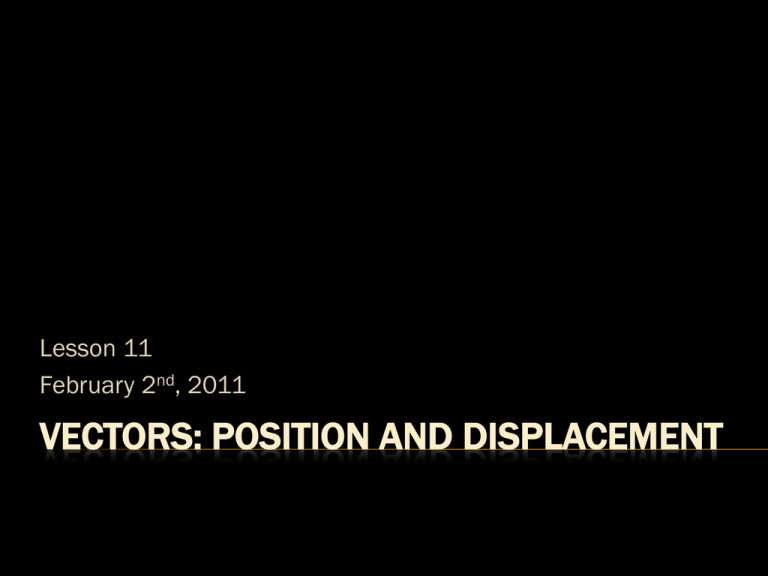
Lesson 11 February 2nd, 2011 VECTORS: POSITION AND DISPLACEMENT If a student said that they had to walk 800m to get to school today, you would only know the distance they travelled and the destination. You would not know their starting point or the directions they took to get here To give directions a reference point is needed. Reference point The point from which position is measured; usually the origin or starting point. If someone were to specify where they walked from, they would need to indicate the direction. [N], [S]. [E], and [W]. Position The separation between and direction from a reference point. Example : 152 m [W] A position must contain a distance and a direction. Vector Quantity A quantity that involves size and a direction. Example: position - 152 [W] Scalar Quantity A quantity that involves only size, but not direction. Example: Mass – 32 kg Vector quantities are represented with symbols that include a small arrow over the quantity symbol. Scalar Quantity Distance Δd Example: 292 km Time Δt Example: 3.0 h Position Displacement Vector quantity Example: 2km [E] of DDECS Example: 292 km [S] NOTE: Scalar quantities never have arrows above them. When distance is traveled in a straight line such as on a track or street, position , is often stated as a positive or negative value relative to a zero point. Displacement A change in position. EXAMPLE: The area outside of the gym where the two hallway of DDECS divide will be the initial position. You arrive at school after lunch realize that you are late when you look at the clock and walk 5 m [E] to the front desk to get a late slip. You then walk to the starting position and continue straight down the [E] hallway for 40 m and stop right in front of room 10. How far have you walked [E]? TOTAL DISTANCE WHAT IS YOUR DISPLACEMENT? SYMBOL FORMAT There is an international convention for writing a vector quantity, using number symbols, SI unit symbols and, and direction symbols. Using words like forwards and backwards can be misinterpreted. Compass points are more internationally organized and scientific. Example: 52 m [N] instead of 52 m up. DRAWING VECTORS An alternative way of communicating vector quantities is to use vectors. A vector is a line segment that represents the size and direction of a vector quantity. The vectors are drawn to scale that should be stated. The vector indicates both size and direction. DRAWING VECTORS 75 km 1 cm = 25 km DRAWING VECTORS 38 km 1 cm = 25 km DRAWING VECTORS 57m 1 cm = 25 m DRAWING VECTORS 19 m 1 cm = 25 m QUESTIONS Classify the following quantities as scalar or vector (A) (3) Distance Mass Position Displacement Time Change in position Distinguish in your own words, the difference between position and displacement. C (2) Why is it convenient to choose your starting point as the reference point when starting your position during your travels? C (3) QUESTIONS Communicate the final position , including a reference point, after each of the following moves. Use symbol format. C (3) A Toronto Blue Jays baseball player is on the first base, 24.4 m east of home plate. The player was on second base, but has managed to steal third base 24.4 m to the west. A batter hits a home run and ends up safely at home plate. Communicate the displacement, , after each of the following moves. Use symbol format. C (3) A puck is shot 25 m from the center ice (red) line south into the Ottawa Senators’ zone. A high school volleyball player, leaps towards the net (north) by 1.9 m while spiking. Kurt Browning completed the first quad jump in competition. He jumped 3.2 m in a easterly direction. QUESTIONS Communicate your answers to in symbol and vector format. C (3) What is your displacement if you walk from home 0.45 km [N] to school and then return home at the end of the day? What is your displacement if you ride a bike 2.0 km [S] and then a further 1.5 km [S]? What is your displacement if you walk 30 m [E] and then back 40 m [W]? A( /3) C ( /15)

